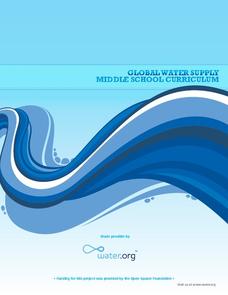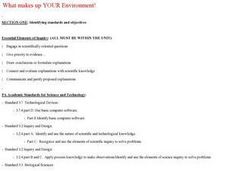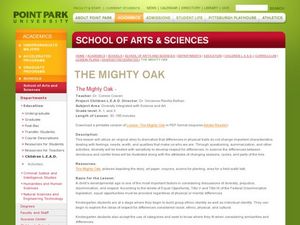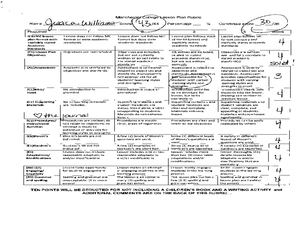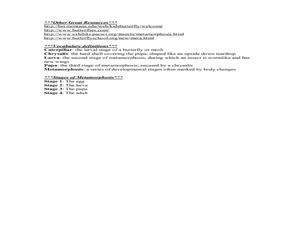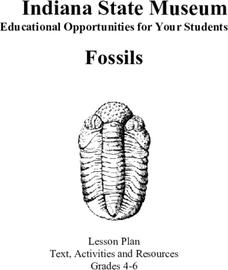New York State Education Department
TASC Transition Curriculum: Workshop 10
How have educational standards evolved? Educators of adults examine expectations in the 10th workshop out of 15 to better determine how standards have grown. Participants respond to a variety of sample questions to determine how they...
Curated OER
Garden Grid
Basically, your class reads about different garden plants from an included handout and seed packets that you provide, and then uses a grid to plan out where to place the plants. They can practice counting with the seeds, grouping,...
Water
Global Water Supply Middle School Curriculum
We take a steady shower stream and clean drinking water for granted, but in many countries around the world, the lack of water or a clean water supply is responsible for higher sickness and death rates. Taking a closer look at the water...
Curated OER
Colors of Wildlife
Students observe wildlife animals. In this wildlife lesson, students cut out three different animals from a wildlife magazine. Then they compare the animals, verbally stating their similarities and differences.
Curated OER
The Plant and Animal Walk
Students draw pictures and write words to describe objects and experiences. They observe outside and draw at least three animals and three plants. Students observe plants and animals describing how they are alike and how they are...
Curated OER
WHAT MAKES A LIGHT BULB LIGHT?
Students are able to use inquiry to answer the essential questions. They are able to predict and test configurations of a battery, bulb, and wire that make the complete circuit. Students craft a group and individual theory of a...
Curated OER
FROG
Studdents are able to identify the metamorphosis of a frog from tadpole to frog. They are able to communicate through writing what they learned about frogs. Students are able to compare what they included in the KWL chart.
Curated OER
Recycling!
The young scholars recall events from Dr. Seuss' story The Lorax and make connections to environmental issues affecting their lives. They are expected to reflect on the facts of the story and respond verbally stating the inferences they...
Discovery Education
Mood Music!
Grouchy? Sad? Here's a great resource that shows kids how music can be used to lift their spirits. Kids collect and chart data on the effects of music on emotions. After analyzing the results of their experiment, they develop...
Curated OER
A Rainbow Under the Sea: How Do Animals Survive in the Ocean?
Second graders, with adult help, create a PowerPoint presentation on a selected ocean animal.
Curated OER
What is Sound? How Can We Change Sound?
In this instructional activity, students investigate the phenomenon of sound! Students compare and contrast how sound travels through solids, liquids, and gases. They explain how length and thickness affect sound. Students know the...
Curated OER
What makes up YOUR Environment!
Students create their own land or water environment. They make their environment livable for all the different animals they collect to put in it. Students research the types of animals that they can have in their environment, and how...
Curated OER
Physical Differences
Students examine physical differences amongst themselves. In this diversity lesson, students read the book We're Different, We're the Same. Students name things about their appearance that is different from the person next to them.
Curated OER
The Mighty Oak
Young scholars investigate types of trees. In this forestry lesson, students read the book The Mighty Oak and act out the story with a partner. Young scholars discuss the types of trees in the book and plant an oak tree on school grounds.
Curated OER
Observing and Writing about Butterflies
Students observe and write about butterflies. In this life cycle instructional activity, students listen to the story The Life of a Butterfly by Robin Bernard and watch a YouTube video of a butterfly coming out of his chrysalis....
Curated OER
Cacao Tree Geography
Young scholars use a map to learn about where chocolate comes from. In this lesson on the cacao tree, students locate various regions where the cacao tree grows. They will discuss why the cacao tree grows more favorably in particular...
Curated OER
Life Cycle of the Monarch Butterfly
Third graders access prior knowledge of the monarch butterfly and discuss what they would like to know. In this Monarch Butterfly lesson,students read Monarch Butterfly and discuss the life cycle of the butterfly. Students gather...
Curated OER
Fossils
Students complete a unit on fossils. They read and discuss informational handouts, define key vocabulary terms, answer discussion questions, create a geologic timeline and a timeline of their own life, analyze bones, and create a fossil...
Curated OER
Determine the molarity of an unknown HCl solution
Students complete a lab to help develop a comprehension of stiochiometry. They review equation writing, equation balancing, and stiochiometry. Studnets are given the following information: Sloppy students from the previous class have...
Curated OER
Too Bee Or Not To Bee
Students recognize that bees are important in the reproduction of plants and to the survival of animals. In this bee lesson, students become familiar with the parts of bees and how those adaptations help them pollinate plants....
Curated OER
What's In Our Backyard?
Eighth graders investigate the importance of an ecosystem by studying their own backyards. In this environmental lesson plan, 8th graders examine a schoolyard or backyard by marking quadrants and recording any animal or plant...
Curated OER
What's Wild
Third graders discover the differences between wild and domestic animals. In this animal lesson plan, 3rd graders chart the differences in the animals and look through magazines for pictures of wild and domestic animals to glue to a...
Curated OER
A Tree for all Seasons
Students investigate seasons. In this environment lesson, students describe the four seasons by drawing an appropriate tree for each season.
Curated OER
Solid Waste and Our Natural Resources: Utilizing the Story THE LORAX
Students gain an introduction to our planet's solid waste problem and our personal responsibility in curbing and solving said problem through the use of Dr. Seuss' book, The Lorax. After hearing the book, class discussion follows.


